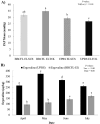Exploring the impacts of fescue toxicosis on the pulmonary arterial pressure of angus cows
- PMID: 39288306
- PMCID: PMC11484796
- DOI: 10.1093/jas/skae279
Exploring the impacts of fescue toxicosis on the pulmonary arterial pressure of angus cows
Abstract
Vasoconstriction of peripheral blood vessels is one of the hallmark symptoms of fescue toxicosis in cattle. Thus, it was hypothesized that exposure to ergot alkaloids would increase the pulmonary arterial pressure (PAP). The objectives of this study were to examine the relationship between PAP and different physiological parameters of cows grazing either endophyte-infected (EI) or novel-endophyte (EN) fescue, then evaluate changes in PAP and other physiological measurements in cows exposed to EI pastures and deemed as susceptible or tolerant based on animal performance. Pregnant Angus cows at 2 different locations grazed either EI or EN fescue pastures for 14 consecutive weeks starting in early April of 2022. Forage measurements were collected to assess ergot alkaloid exposure throughout the study. In addition to measuring PAP, weekly measurements and blood samples were collected to evaluate physiological responses to ergot alkaloid consumption. The Fescue Toxicosis Selection Method (FTSM) was used for a post hoc analysis to identify cattle as either tolerant (EI-TOL) or susceptible (EI-SUS) when challenged with ergot alkaloid exposure. Data were analyzed using a MIXED procedure of SAS with repeated measures. Cows grazing on EN pastures had greater mean PAP values than EI cows, (P < 0.01), whereas a location effect was identified when comparing both EI-TOL and EI-SUS groups (P < 0.01). Cows exposed to EN pastures had greater average daily gain (ADG) (P = 0.04) and progesterone (P4) concentrations (P < 0.01), and lower hair shedding scores (HSS; P < 0.01) than EI cows. The EI-TOL cows tended to have greater final body weight, ADG and had lower HSS (P < 0.01) than EI-SUS cows. While cattle consuming EI tall fescue exhibited classical physiological changes, the decrease in PAP of cattle consuming EI fescue was unexpected and contradicted the initial hypothesis. Furthermore, the FTSM provides a means to identify animals with superior performance in spite of the chronic exposure to ergot alkaloids. Continued investigations examining the interaction between ergot alkaloid exposure and cardiovascular parameters will lead to a fuller understanding of the disease and are pivotal for developing innovative strategies that enhance best management practices to help guarantee the sustainability of the U.S. beef industry.
Keywords: fescue toxicosis; pregnant cows; pulmonary arterial pressure.
Plain language summary
Since ergot alkaloids were identified as the causative agent of fescue toxicosis in cattle that grazed on endophyte-infected tall fescue pastures, multiple studies have been designed to understand the disease and develop strategies to minimize its negative effects on cattle performance. One of the major consequences of this disease is vasoconstriction, which alters the normal functioning of the cardiovascular system. Therefore, the objective of this study was to examine the relationship between pulmonary arterial pressure (PAP) and different physiological parameters of cows exposed to ergot alkaloids. The evaluation of the interaction between PAP and fescue toxicosis is innovative to beef cattle research in the United States. The results obtained in this study provide a new perspective to analyze the impact of ergot alkaloids on the cardiopulmonary system of cattle and demonstrates that this multifaceted disease demands a multifaceted research approach.
© The Author(s) 2024. Published by Oxford University Press on behalf of the American Society of Animal Science. All rights reserved. For commercial re-use, please contact reprints@oup.com for reprints and translation rights for reprints. All other permissions can be obtained through our RightsLink service via the Permissions link on the article page on our site—for further information please contact journals.permissions@oup.com.
Conflict of interest statement
The authors declare that there is no conflict of interest that could be perceived as prejudicing the impartiality of the research reported.
Figures




Similar articles
-
Influence of heat stress and fescue toxicosis on the pulmonary arterial pressure of beef heifers.J Anim Sci. 2025 Jan 4;103:skaf059. doi: 10.1093/jas/skaf059. J Anim Sci. 2025. PMID: 40036246 Free PMC article.
-
Examining the long-term impacts of ergot alkaloids on fetal heifer development and subsequent growth and reproductive performance.J Anim Sci. 2024 Jan 3;102:skae210. doi: 10.1093/jas/skae210. J Anim Sci. 2024. PMID: 39073441 Free PMC article.
-
Impact of slick hair trait on physiological and reproductive performance in beef heifers consuming ergot alkaloids from endophyte-infected tall fescue1.J Anim Sci. 2019 Apr 3;97(4):1456-1467. doi: 10.1093/jas/skz024. J Anim Sci. 2019. PMID: 30772895 Free PMC article.
-
BILL E. KUNKLE INTERDISCIPLINARY BEEF SYMPOSIUM: Coping with tall fescue toxicosis: Solutions and realities.J Anim Sci. 2015 Dec;93(12):5487-95. doi: 10.2527/jas.2015-9229. J Anim Sci. 2015. PMID: 26641158 Review.
-
BILL E. KUNKLE INTERDISCIPLINARY BEEF SYMPOSIUM: Does tall fescue toxicosis negatively impact bull growth and breeding potential?J Anim Sci. 2015 Dec;93(12):5522-8. doi: 10.2527/jas.2015-9216. J Anim Sci. 2015. PMID: 26641162 Review.
Cited by
-
Influence of heat stress and fescue toxicosis on the pulmonary arterial pressure of beef heifers.J Anim Sci. 2025 Jan 4;103:skaf059. doi: 10.1093/jas/skaf059. J Anim Sci. 2025. PMID: 40036246 Free PMC article.
References
-
- Aiken, G. E., Klotz J. L., Looper M. L., Tabler S. F., and Schrick F. N... 2011. Disrupted hair follicle activity in cattle grazing endophyte-infected tall fescue in the summer insulates core body temperatures. Prof. Anim. Sci. 27:336–343. doi:10.15232/s1080-7446(15)30497-6 - DOI
MeSH terms
Substances
LinkOut - more resources
Full Text Sources
Research Materials
Miscellaneous

